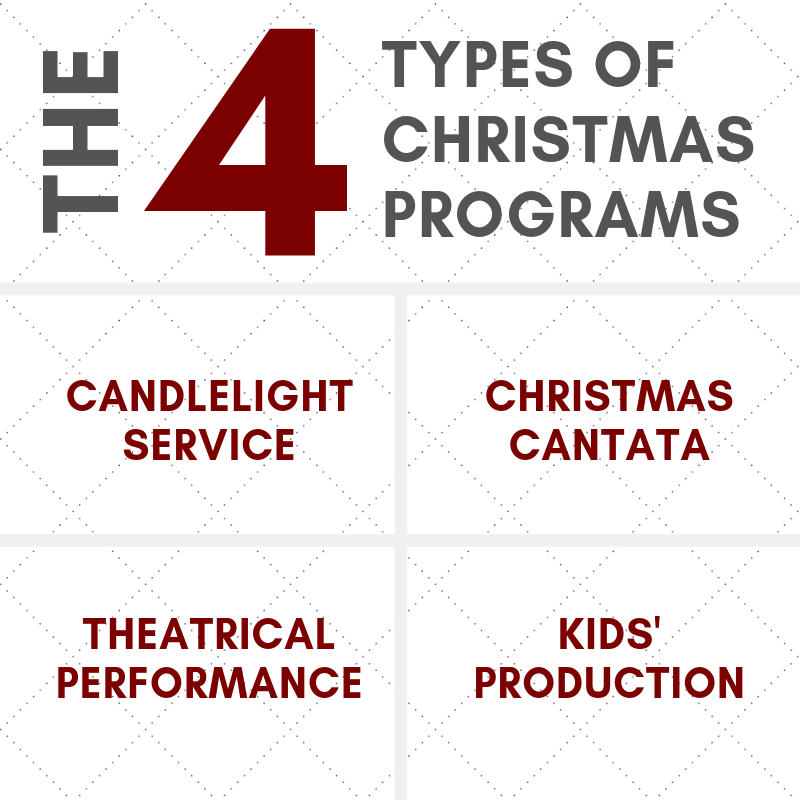I thrive with boundaries – a definition, a rule, a general structure – these give me clarity and help me understand something that’s vague. They also help me communicate to others.
When I first started writing Christmas Eve service scripts and tried to explain the concepts I had, some people heard “different than what we normally do” (a sermon-based program with some special music” and immediately thought full-on dramatic production with costumes, sets, the works.
That wasn’t what I had in mind at all. So this is how I break down the artistic world of Christmas programs in the conservative church.
What’s ironic is since writing this, I myself have broken out of these styles – especially with my latest script, Hadassah of Susa, which is a 40-minute monologue broken up with congregational singing.
And certainly the characteristics or types I outline below are by no means a hard and fast rule – anything creative allows for fluidity, mixing-and-matching, and really crafting a service that is unique to your vision.
Oh well, these are still general categories that might be helpful if you need shorter terms for reference, or if your church family has been stuck in one specific style for many years of same-old, same-old Christmas programs and is ready to try something (just a little) different.
If you haven’t yet, be sure to read The Ultimate Church Questionnaire to guide you through picking the production style that will be the best fit for your specific situation.

Candlelight Service
It’s quiet, it’s sober, it’s rejoicing.
Speakers present their own devotionals (either multiple short ones or one sermon that is the bulk of the service) and the ‘specialness’ of the service is highlighted by extra music, dim lighting, and of course a traditional candlelighting ceremony at the end.
Emmanuel: The Promise Fulfilled is a textbook Candlelight Service (You can download the FREE outline & production guide here). It requires 5 lay speakers, opens and closes with congregational singing, and speckles special music throughout.
While simple, a Candlelight Service doesn’t have to be boring. Building the service around one strong theme, adding in special moments, giving your speaker/s strong guidance, and choosing powerful music with keep it anything but blase.
Check out this post that includes 15 different concepts and several dozen elements you can choose from while you’re developing your service.
Christmas Cantata
The main characteristics of a Christmas Cantata are a heavy emphasis on music, and a touch of the dramatic. This style often also involves monologues, narrators, and a tight blend of words and music.
First off, the script. This style is more work than a Candlelight Service because instead of delegating some of the writing to your speakers, you (or your team) are creating the word-for-word complete script.
It begins to blend in elements of a theatrical performance – perhaps more lighting changes, some background sound effects, maybe a monologue is performed in costume.
Or perhaps the program is entirely music-based, with little to no spoken words, instead conveying the meaning through a series of songs, both instrumental and sung, and maybe augmented by videos projected across the backdrop.
Both Light Out of Darkness (Christmas Eve) and The Curse & the Cross (Good Friday) are written in a cantata style.
Theatrical Performance
A theatrical production has a heavy emphasis on acting in character. It’s highly visual, and creates an immersive experience for your audiences through set pieces, costumes, makeup, lighting, sound effects, etc.
What to consider: The set pieces and costumes make the production cost much higher; it’s also difficult to avoid a kitschy design (so check out our Staging Inspiration Pinterest board for ideas on succeeding with this!). Theatrical productions also generally require a higher time commitment from your tech team and participants, to ensure that the pieces flow smoothly.
Do you have enough acting talent to pull off a multi-character production?Also consider your church’s culture around acting and performance. Would actors be seen as showing off or attention-seeking? If so, consider easing into this style by including one or two costumed performance monologues as part of a Candlelight or Cantata style production.
A note: there certainly is a way to do a scaled-back variation of this style, like a radio theater setup or using a minimalistic set and costuming- almost a blend between the Theatrical and the Cantata styles. As I mentioned before, anything creative like this is a spectrum, and you can land on it wherever you choose!
Kids’ Production
A Kids’ Production is the junior version of a blend of the Cantata and the Theatrical. It usually relies heavily on songs, with readings and recitations interspersed. Since the production is carried by children, the audience tolerance for thrown-together costumes, amateur acting ability, and cardboard scenery is generally much higher than it would be for the Theatrical performance.
Kids’ productions don’t necessarily exclude teens and adults – some churches may choose to cast adults in the main roles, or as narrators/readers, and certainly behind the scenes. The defining characteristic is that kids are highlighted.
What to consider:
Do you have plenty of kids at your church?
Do you have an engaged youth program and Sunday School program?
If so, there’s a great opportunity for delegating portions of the program to the teachers/youth leaders, and also preset rehearsal times. It’s much easier to have classes practice their song/section for 15 minutes out of an hour-long Sunday School class, than it is to arrange a time for parents to bring their kids back outside of the regular church schedule.
Will parents be willing to provide the volunteer time and cost needed to bring their children to rehearsals (if needed), help put together sets, provide the costume for their child, and remind their child to practice the part, during the Christmas season? Some families would find this a happy tradition to be part of; others will be overwhelmed by yet another holiday activity.
How to choose a style
Consider mapping out what your church has done in the past – what genres does it fall into? Is your goal to stay squarely in the same style, or stretch it towards something else? If you’re looking to stretch a bit, consider what elements of the other styles you might be able to incorporate.
And be sure to read The Ultimate Church Questionnaire to guide you through picking the production style that will be the best fit for your specific situation.
What you’ll find here
I Organized That specializes in the Candlelight & Cantata styles – they’re what I primarily have experience in and have written scripts for.

